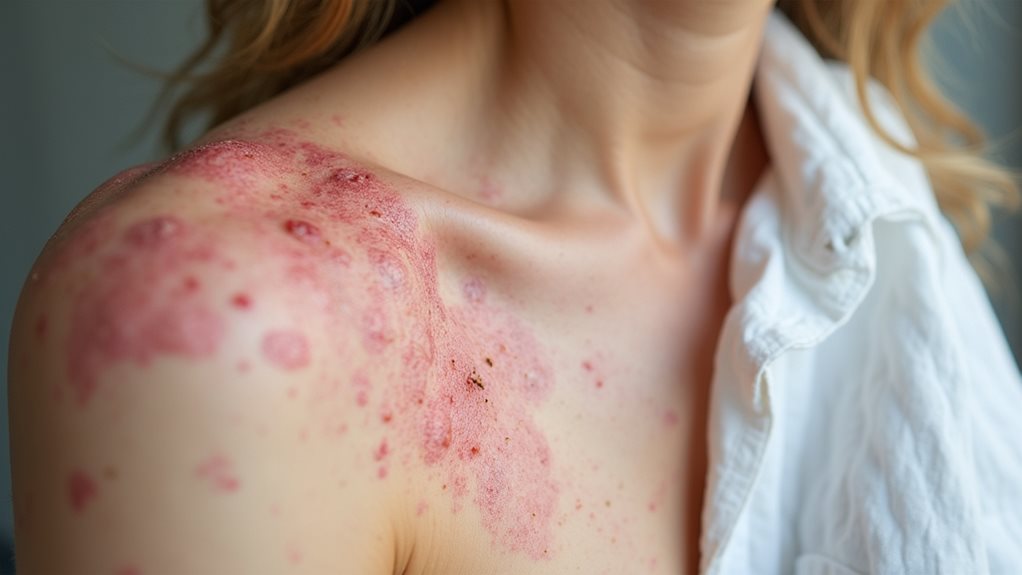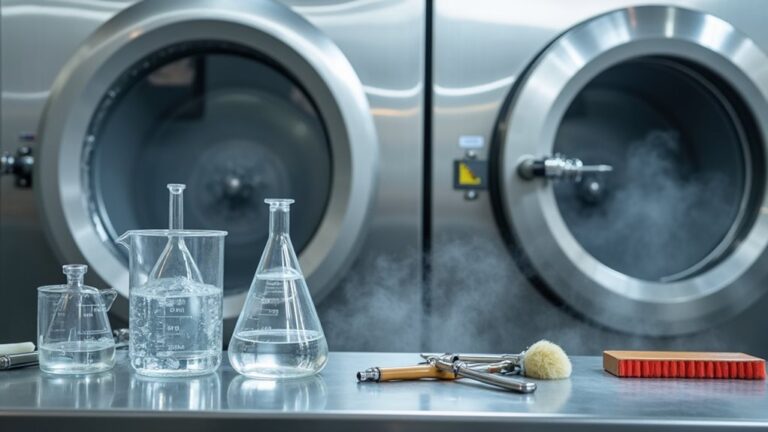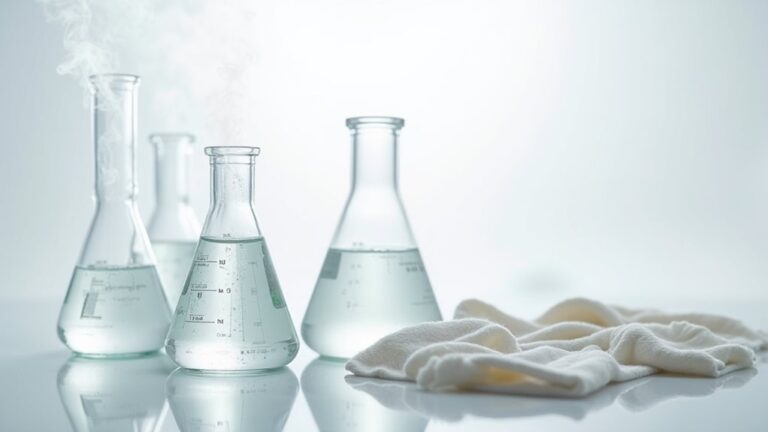Yes, dry cleaning can absolutely cause rashes through chemical exposure, particularly from perchloroethylene (PERC), a common solvent that clings to fabrics and triggers contact dermatitis. You’ll notice symptoms like redness, itching, burning sensations, or even blisters within hours or days of wearing freshly cleaned garments. The irritation happens because these harsh chemicals remain on your clothes, especially wool and cotton items, creating direct skin contact that leads to inflammation. There’s much more you can do to protect yourself.
Understanding the Link Between Dry Cleaning and Skin Reactions
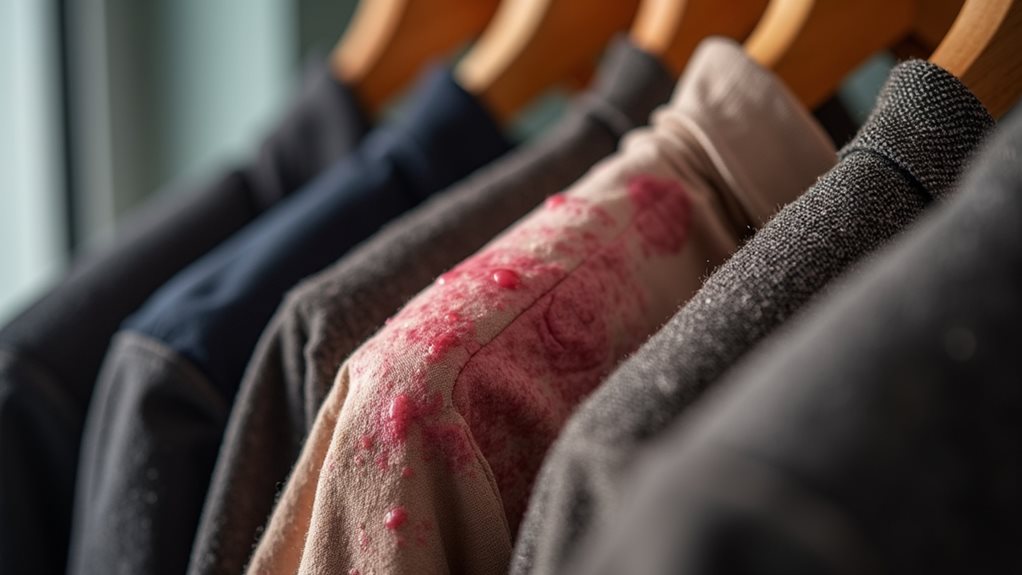
When you slip into that freshly dry-cleaned blazer for an important meeting, you probably aren’t thinking about the invisible chemical residues that might be lurking in the fabric fibers, waiting to wage war on your skin.
The truth is, dry cleaning chemicals can absolutely trigger skin irritation, and it’s more common than you’d think. Contact dermatitis from these chemical residues manifests as that annoying redness, swelling, and itching that makes you want to scratch like crazy during presentations 😅.
The culprit is often perchloroethylene, which clings stubbornly to fabrics. If you’re prone to skin sensitivity, consider seeking out dry cleaners offering hypoallergenic or eco-friendly cleaning methods—your skin will thank you later.
To minimize exposure, always allow freshly dry-cleaned garments to air out completely before wearing them, as this helps reduce chemical residues that can trigger reactions in sensitive individuals.
Chemical Culprits: Perchloroethylene and Other Irritants
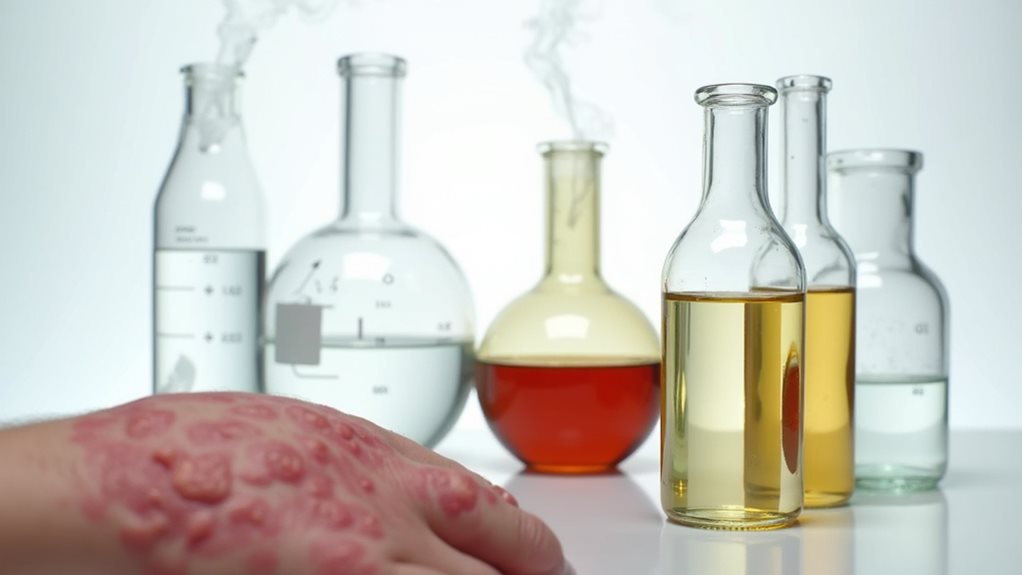
Three main chemical villains lurk in your freshly cleaned garments, and perchloroethylene—or PERC as it’s commonly called—stands as the biggest troublemaker of them all.
This cleaning solvent, classified as a human carcinogen, doesn’t just vanish after your clothes are cleaned—it lingers like an unwelcome guest at a party 😅.
Georgetown University researchers discovered that wool and cotton fabrics retain notable PERC levels, creating a recipe for skin rashes and allergic reactions, especially if you’re already dealing with sensitive skin or eczema.
But PERC isn’t working alone; other irritants including detergents, bleach, and precleaning agents join forces to potentially trigger contact dermatitis, turning your wardrobe into an unexpected source of irritation.
Beyond skin reactions, PERC exposure has been linked to neurological problems, liver damage, and reproductive issues, making it particularly concerning for vulnerable populations like pregnant women and children.
Types of Skin Conditions Triggered by Dry Cleaning
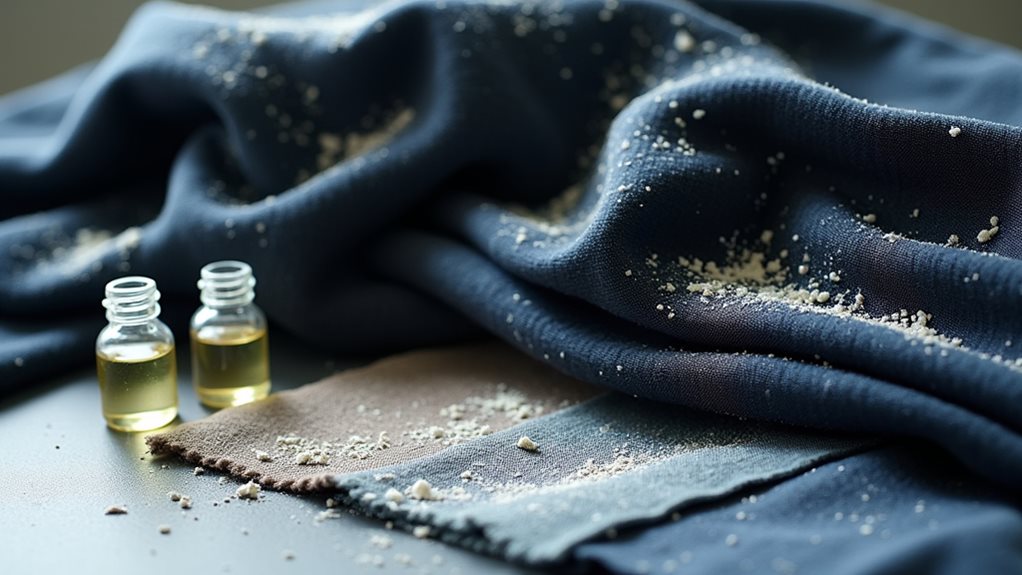
Although your skin might seem tough enough to handle whatever life throws at it, dry cleaning chemicals can release a surprising variety of reactions that’ll leave you scratching your head—and unfortunately, scratching everything else too.
The most common culprit you’ll encounter is irritant contact dermatitis, where toxic cleaning chemicals like perchloroethylene create immediate redness and swelling that feels like an angry sunburn.
Then there’s allergic contact dermatitis, a sneaky delayed reaction where your immune system decides those lingering chemical residues are unwelcome guests, triggering itchy rashes days later.
If you’re already dealing with eczema, these skin problems become even more pronounced, and repeated visits to certain dry cleaners can lead to chronic fissuring and persistent irritation that’s honestly just miserable.
Fortunately, many dry cleaners now offer eco-friendly cleaning methods such as wet cleaning and CO2 cleaning that use biodegradable solvents, which can significantly reduce the risk of skin reactions for sensitive individuals.
Identifying Symptoms of Chemical-Induced Dermatitis
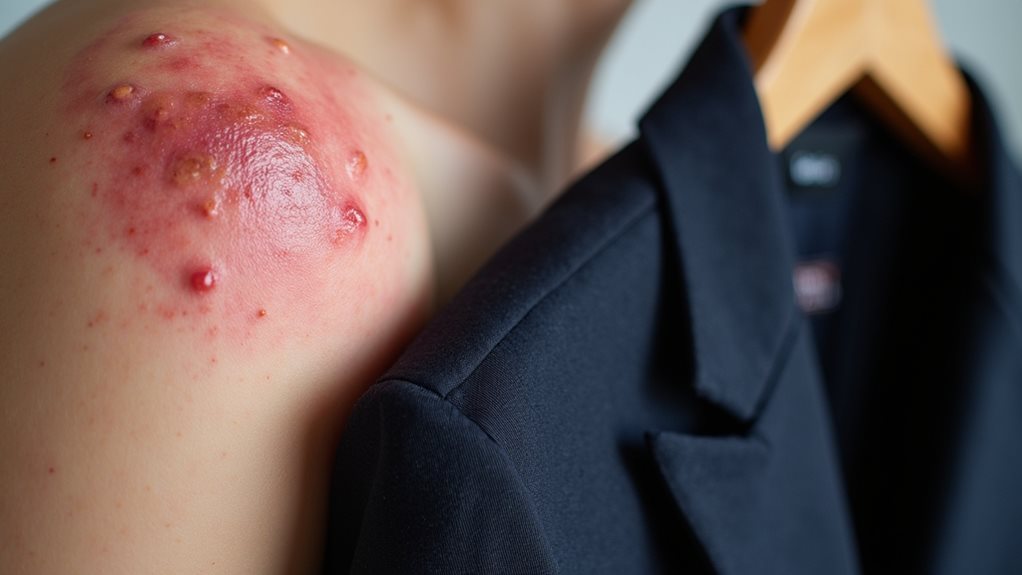
When you suspect your dry-cleaned clothes might be causing that annoying rash, you’ll want to pay close attention to how your skin reacts immediately after wearing them, since chemical exposure symptoms can range from mild redness to intense itching that makes you want to scratch like crazy.
The tricky part about identifying chemical-induced dermatitis is that your skin doesn’t always throw up red flags right away – sometimes it takes hours or even days for those telltale bumps, blisters, or dry patches to make their grand appearance, which can make connecting the dots between your favorite blazer and that mysterious rash pretty challenging.
I’ve learned the hard way that keeping track of when symptoms appear after wearing freshly dry-cleaned items can be your best detective tool, especially since the timeline of skin reactions often holds the key to figuring out whether those harsh cleaning chemicals are the real culprit behind your discomfort.
The most common reactions include burning sensations alongside the typical redness and itching, particularly when perchloroethylene or other harsh solvents haven’t been completely removed from the fabric during the cleaning process.
Chemical Exposure Symptoms
Because I’ve experienced my fair share of mysterious rashes over the years, I can tell you that identifying chemical-induced dermatitis from dry cleaning isn’t always as straightforward as you’d expect.
Chemical exposure from dry cleaners can trigger sneaky skin reactions that leave you scratching your head (literally) 😅.
Here’s what you should watch for when allergens from those freshly cleaned clothes hit your skin:
- Immediate irritation – redness, swelling, and that annoying itchy feeling within hours
- Delayed reactions – blisters or scaling that appear days later, making the connection tricky
- Location patterns – rashes appearing where clothing touches your body most
- Worsening symptoms – if you already have a skin condition like eczema, expect amplified reactions
The tricky part? Dermatitis symptoms can mimic other conditions, so timing really matters when connecting dots.
These reactions are often caused by perchloroethylene and other harsh solvents that can remain on fabrics after inadequate rinsing or ventilation during the cleaning process.
Skin Reaction Timeline
Since understanding when symptoms actually show up can mean the difference between quickly identifying the culprit and weeks of uncomfortable detective work, I’ve learned to pay close attention to my skin’s timeline after picking up dry cleaning.
Chemical-induced dermatitis from cleaning solvents like perchloroethylene doesn’t follow a predictable schedule, which honestly makes it more frustrating to pinpoint.
If you’re dealing with irritant contact dermatitis, your skin might react within hours, showing redness and swelling where the fabric touched you.
However, allergic reactions to allergens in dry cleaning chemicals can be sneakier, taking anywhere from several hours to days before rashes and itching appear.
Your individual sensitivity level determines how quickly and severely your skin responds to these chemical exposures.
Choosing Safer Dry Cleaning Alternatives

If you’ve ever experienced that annoying itch or mysterious rash after picking up your favorite blazer from the dry cleaner, you’re definitely not alone in wondering whether there’s a better way to keep your clothes fresh without turning your skin into a science experiment.
Here’s how you can find safer alternatives:
- Ask about solvents – Inquire whether your dry cleaners use non-toxic alternatives like liquid carbon dioxide instead of harsh chemicals.
- Seek certifications – Look for businesses that offer hypoallergenic cleaning services with documented green cleaning methods.
- Try home kits – Consider DIY options with gentler formulations for delicate items.
- Air everything out – Let freshly cleaned clothes breathe in well-ventilated spaces to eliminate chemical residues before wearing.
Many dry cleaners are transitioning away from perchloroethylene (PERC) and other harsh chemicals to safer alternatives like liquid CO2 and hydrocarbon solvents.
Your skin deserves better than playing chemical roulette!
Prevention Strategies for Sensitive Skin

When you’ve got sensitive skin that reacts to practically everything, taking proactive steps before your clothes even touch your body becomes your best defense against those frustrating post-dry cleaning breakouts.
Smart prevention strategies start with choosing hypoallergenic or eco-friendly dry cleaners who skip harsh chemicals like perchloroethylene – trust me, your skin will thank you later! 😊
Always air out freshly cleaned garments in a well-ventilated space before wearing them, giving those lingering chemical vapors time to dissipate completely.
Consider investing in breathable garment bags for transport, which minimize your exposure to residual solvents.
For the ultra-cautious (like myself after one too many rash incidents), steam cleaning or non-toxic home kits offer gentler alternatives that keep sensitive skin happy while maintaining your wardrobe’s pristine appearance.
Many dry cleaners are now transitioning to safer alternatives like hydrocarbon solvents and wet cleaning methods, which significantly reduce the risk of skin irritation for sensitive individuals.
Treatment Options for Dry Cleaning-Related Rashes
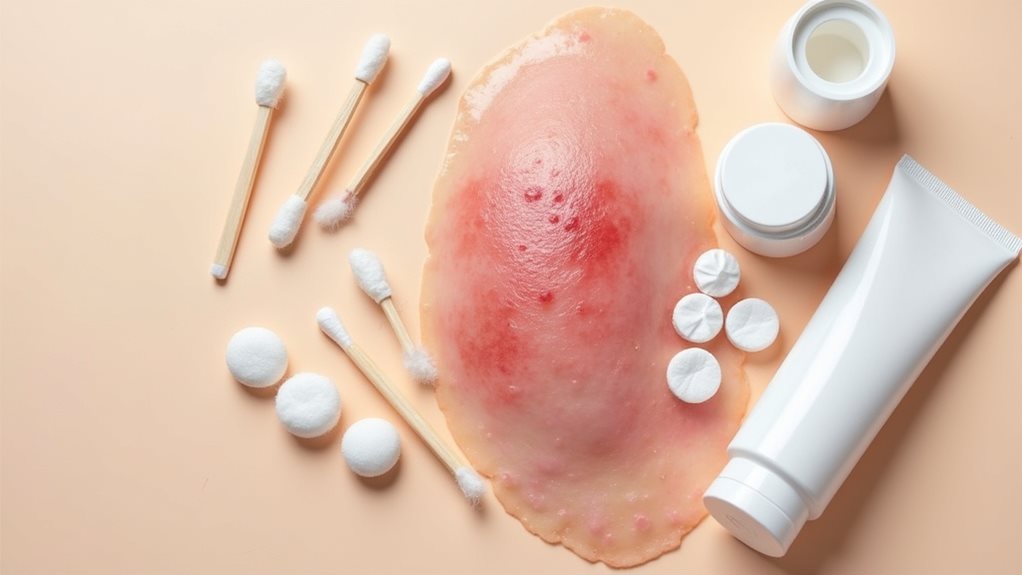
If you’ve developed a rash from dry cleaning chemicals, you’ll want to focus on two main approaches: getting immediate relief from the uncomfortable symptoms, and seeking appropriate medical treatment when the situation calls for it.
I learned this the hard way after ignoring a persistent rash for weeks, thinking it would just disappear on its own – spoiler alert, it didn’t! 😅
The good news is that there are effective strategies for both quick comfort measures you can try at home, as well as professional medical interventions that can address more serious or stubborn reactions.
Most dry cleaning-related skin irritation stems from PERC residues that remain on garments when they haven’t been properly aired out after the cleaning process.
Immediate Relief Methods
Although discovering an angry, red rash after wearing your freshly dry-cleaned blazer feels like a cruel joke from the universe, you don’t have to suffer through the itching and irritation while wondering if you’ll ever trust professional cleaning again.
Your skin’s screaming for immediate relief, and thankfully, you’ve got several effective options right at your fingertips.
Here’s your action plan for soothing that chemical-induced chaos:
- Apply a topical corticosteroid cream to calm inflammation and stop the maddening itch.
- Take antihistamines to combat allergic reactions and reduce swelling.
- Gently cleanse with mild soap to remove lingering chemical residue.
- Focus on moisturizing with emollient creams to repair your compromised skin barrier.
These steps’ll have you feeling human again! 🙌
Medical Treatment Options
Sometimes those quick relief methods just aren’t enough to tackle the stubborn, angry rash that’s turned your skin into a battlefield, and that’s exactly when you need to call in the medical professionals who’ve seen every possible reaction to dry cleaning chemicals.
Your dermatologist might prescribe topical corticosteroids to calm that inflammation down, because honestly, your skin’s throwing a tantrum that needs serious intervention.
Antihistamines can work wonders for allergic reactions, especially when you’re dealing with hives that make you look like you’ve wrestled with poison ivy.
For persistent cases, patch testing helps identify specific allergens lurking in those cleaning agents.
Don’t forget moisturizers—they’re crucial for rebuilding your skin barrier after dermatitis strikes! 💪

